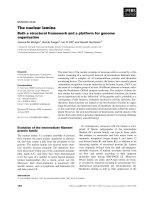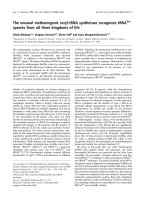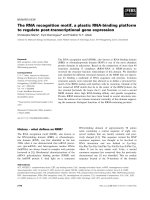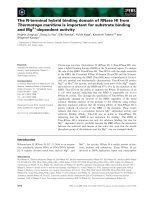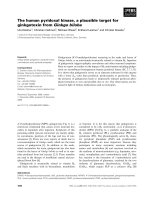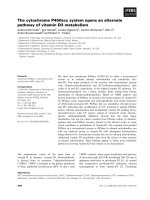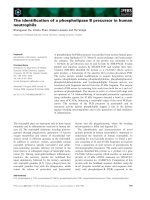Báo cáo khoa học: The human pyridoxal kinase, a plausible target for ginkgotoxin from Ginkgo biloba docx
Bạn đang xem bản rút gọn của tài liệu. Xem và tải ngay bản đầy đủ của tài liệu tại đây (361.41 KB, 10 trang )
The human pyridoxal kinase, a plausible target for
ginkgotoxin from Ginkgo biloba
Uta Ka
¨
stner
1
, Christian Hallmen
2
, Michael Wiese
2
, Eckhard Leistner
1
and Christel Drewke
1
1 Institut fu
¨
r Pharmazeutische Biologie, Universita
¨
t Bonn, Germany
2 Pharmazeutisches Institut, Pharmazeutische Chemie, Endenich, Bonn, Germany
4¢-O-methylpyridoxine (MPN, ginkgotoxin; Fig. 1) is a
neurotoxic compound that causes severe neuronal dis-
orders in mammals after ingestion. Symptoms of this
poisoning called ‘gin-nan sitotoxism’ are mainly epilep-
tic convulsions, paralysis of the legs and loss of con-
sciousness [1]. There are even reports of death due to
overconsumption of Ginkgo seeds, which are the main
source of ginkgotoxin [1]. In addition to the seeds,
which accumulate the toxin, ginkgotoxin has also been
found in the leaves of Ginkgo biloba as well as in rem-
edies produced from leaf extracts [2,3]. These remedies
are used in the therapy of insufficient central and per-
ipheral blood flow [4].
Ginkgotoxin is structurally related to vitamin B
6
and likely interferes with its biosynthesis, metabolism
or function. It is for this reason that ginkgotoxin is
considered to be a B
6
‘antivitamin’, as is 4¢-deoxypyri-
doxine (DPN) [5] (Fig. 1), a synthetic analogue of the
B
6
vitamers pyridoxal (PL), pyridoxamine (PM) and
pyridoxine (PN). The physiologically active B
6
vitam-
ers pyridoxal phosphate (PLP) and pyridoxamine
phosphate (PMP) are most important, because they
participate in many enzymatic reactions including
amino acid metabolism [6] and reactions involved in
the synthesis of neurotransmitters (e.g. dopamine, sero-
tonin, norephedrine and c-aminobutyric acid) [7]. One
key reaction is the formation of c-aminobutyric acid
by decarboxylation of glutamate, catalysed by the two
isoforms of glutamate decarboxylase, GAD
65
and
GAD
67
, which require PLP as a cofactor (Fig. 2B)
Keywords
Ginkgo biloba; ginkgotoxin; pyridoxal kinase;
c-aminobutyric acid; pyridoxal phosphate
Correspondence
C. Drewke, Institut fu
¨
r Pharmazeutische
Biologie, Rheinische Friedrich-Wilhelms-
Universita
¨
t Bonn, Nussallee 6, 53115 Bonn,
Germany
Fax: +49 228 733250
Tel. +49 228 732563
E-mail:
Website: />(Received 5 September 2006, revised
11 December 2006, accepted 15 December
2006)
doi:10.1111/j.1742-4658.2007.05654.x
Ginkgotoxin (4¢-O-methylpyridoxine) occurring in the seeds and leaves of
Ginkgo biloba, is an antivitamin structurally related to vitamin B
6
. Ingestion
of ginkgotoxin triggers epileptic convulsions and other neuronal symptoms.
Here we report on studies on the impact of B
6
antivitamins including ginkgo-
toxin on recombinant homogeneous human pyridoxal kinase (EC 2.7.1.35).
It is shown that ginkgotoxin serves as an alternate substrate for this enzyme
with a lower K
m
value than pyridoxal, pyridoxamine or pyridoxine. Thus,
the presence of ginkgotoxin leads to temporarily reduced pyridoxal phos-
phate formation in vitro and possibly also in vivo. Our observations are dis-
cussed in light of Ginkgo medications used as nootropics.
Abbreviations
DPN(P), 4¢-deoxypyridoxine(phosphate); GAD, glutamate decarboxylase; MPN(P), 4¢-O-methylpyridoxine(phosphate), ginkgotoxin(phosphate);
PKH, human pyridoxal kinase; PL(P), pyridoxal(phosphate); PM(P), pyridoxamine(phosphate); PN(P), pyridoxine(phosphate).
1036 FEBS Journal 274 (2007) 1036–1045 ª 2007 The Authors Journal compilation ª 2007 FEBS
[8,9]. This reaction is crucial for maintaining the bal-
ance between c-aminobutyric acid, the main inhibitory
neurotransmitter, and glutamate, the main excitatory
neurotransmitter in the brain. Because of a disregula-
tion of neuronal excitability, a decrease in the c-ami-
nobutyric acid level often is accompanied by epileptic
seizures after induction by antivitamin B
6
agents [10].
Likewise, an imbalance between the levels of glutamate
and c-aminobutyric acid has also been observed in rat
brain after intoxication with ginkgotoxin [11]. Thus,
there is an obvious connection between the main
symptoms of gin-nan sitotoxism and the disregulation
of c-aminobutyric acid metabolism. This disregulation
has been explained by reduced GAD activity [10]. In
N
OH
R
CH
2
OH
N
OH
R
CH
2
O P
N
OH CH
2
O P
CHO
N
OH CH
2
OH
CHO
N
CH
2
OHOH
CHO
PM or PN PMP or PNP
R = CH
2
NH
2
or CH
2
OH
ATP
FMN
(1) (2)
ATP
(1)
PL
PL
PLP
ATP
(4)
Pi
(3)
I
II
I
A Interconversion of B
6
-vitamers
I Reactions of the salvage pathway
(1), (2)
II Reactions before (3) and after (4)
passage through a cell membrane
(e.g. blood brain barrier)
B Metabolism of neurotransmitter
glutamate γ −aminobutyric acid (GABA)
PLP
CO
2
(5)
Fig. 2. Reactions potentially affected by B
6
antivitamins (ginkgotoxin, deoxypyridoxine). (1,4), Pyridoxal kinase; (2), pyridoxine ⁄ pyridoxamine
phosphate oxidase; (3), pyridoxal phosphatase; (5), glutamate decarboxylase.
Fig. 1. B
6
antivitamins ginkgotoxin (phosphate) and 4¢-deoxypyridoxine (phosphate).
U. Ka
¨
stner et al. Influence of ginkgotoxin on human pyridoxal kinase
FEBS Journal 274 (2007) 1036–1045 ª 2007 The Authors Journal compilation ª 2007 FEBS 1037
cases of intoxication with ginkgotoxin, the decreased
availability of c-aminobutyric acid was assumed to be
caused by an inhibitory effect of the toxin on one or
both of the GAD isoenzymes due to the structural fea-
tures of ginkgotoxin [12].
To clarify these assumptions, the influence of gin-
kgotoxin on both GAD isoenzymes was examined at
the enzymatic level [8]. Although a significant decrease
in GAD
65
activity, to 35% of initial values, was
observed when GAD was incubated with 4¢-O-methyl-
pyridoxine 5¢-phosphate (ginkgotoxin phosphate,
MPNP; Fig. 1), the concentration of ginkgotoxin phos-
phate at which this inhibition took place (IC
50
¼
2.7 mm) probably is too high to be reached under phy-
siological conditions. Thus, the GAD isoenzymes could
be ruled out as direct targets for ginkgotoxin or its
phosphate in vivo [8].
However, PLP-dependent GAD can be influenced
indirectly by ginkgotoxin via the reduced availability
of enzyme cofactor due to an inhibition of enzymes
involved in PLP formation. Whereas plants and most
microorganisms are able to biosynthesize vitamin B
6
,
mammals depend on the uptake of B
6
vitamers and
their conversion to PLP. Phosphorylated dietary pre-
cursors of PLP have to be dephosphorylated prior to
resorption in the intestine [13,14]. Bound to albumin
vitamin B
6
derivatives are then distributed via the
bloodstream. They are phosphorylated in the liver to
their respective 5¢-phosphate esters by pyridoxal kinase
and eventually oxidized by pyridoxine ⁄ pyridoxamine
phosphate oxidase [7]. Both enzymes are part of the
vitamin B
6
‘salvage pathway’ (Fig. 2A). PLP is then
transported in the blood to different organs. However,
before passage through the blood–brain barrier circula-
ting PLP has to be dephosphorylated again by mem-
brane-bound phosphatases (Fig. 2A) [13,14]. Inside the
brain a rephosphorylation to PLP takes place, again
catalysed by pyridoxal kinase (Fig. 2A) [7,14]. As a
consequence, there is a requirement for ubiquitous
expression of the kinase in mammalian tissues [14,15].
In the case of inhibition of the enzyme by ginkgotoxin
(phosphate) the availability of cofactor not only for
GAD, but also for all other PLP-dependent reactions
involved in neurotransmitter and amino acid metabo-
lism would be decreased resulting in a total physiologi-
cal imbalance of metabolism, very likely accompanied
by diverse pathological symptoms. Thus, human pyrid-
oxal kinase (PKH) obviously plays a crucial role in the
regulation of PLP homoeostasis. To elucidate the role
of this important enzyme and the mode of action of
ginkgotoxin in more detail, we studied recombinant
PKH as a possible target for ginkgotoxin.
Results
Properties of PKH
PKH catalyses the conversion of PL, PN and PM
(Fig. 2A) to the respective 5¢-phosphate esters using
ATP as a cofactor [15,16]. To examine the mode of
action of ginkgotoxin on PKH, we overexpressed and
purified the enzyme leading to a homogeneous protein
of the expected molecular mass as proven by
SDS ⁄ PAGE (data not shown) and by MALDI-TOF
spectroscopy (see Supplementary material).
PKH was characterized with respect to its biochemi-
cal properties. The enzymatic activity was stable at
)20 °C for 21 days. The enzyme was only active in
the presence of ATP. In contrast, no activity could be
detected with GTP.
Maximum activity was observed for a pH range
5.8–6.3. Accordingly, all measurements were performed
at pH 6.2. The velocity of the reaction showed a sharp
optimum at 45 °C. However, to create physiological
conditions for determination of the effect of ginkgo-
toxin on the human enzyme, further measurements
were carried out at 37 °C.
Identification of ginkgotoxin as a substrate
of PKH
Incubation of PKH with ginkgotoxin in the presence of
ATP gave a new compound, which during HPLC co-
chromatographed with a synthetic sample of the
5¢-phosphate ester of ginkgotoxin and showed a time-
dependent formation (see Supplementary Fig. S2).
Treatment of the product with alkaline phosphatase
reversed the reaction: ginkgotoxin was formed at the
expense of the newly detected compound indicating
that the new metabolite was indeed identical to ginkgo-
toxin phosphate (see Supplementary material). The
experiment shows that the kinase phosphorylates not
only B
6
vitamers (Fig. 2) but also ginkgotoxin. Like-
wise, incubations of PKH with DPN revealed that this
synthetic antivitamin was also phosphorylated (data
not shown).
In order to determine the kinetic data for PL, PN,
PM, MPN and DPN, two different test systems were
employed: an HPLC assay and an optical test, in which
phosphorylation of pyridoxal was measured (see Experi-
mental procedures). The kinetic data given in Table 1
reveal that among all vitamin B
6
derivatives tested, the
antivitamin DPN is the substrate with the highest maxi-
mum velocity (2.62 · 10
)6
nmolÆmg
)1
Æmin
)1
) and the
highest turnover number (k
cat
¼ 1.535 s
)1
), whereas the
Influence of ginkgotoxin on human pyridoxal kinase U. Ka
¨
stner et al.
1038 FEBS Journal 274 (2007) 1036–1045 ª 2007 The Authors Journal compilation ª 2007 FEBS
antivitamin ginkgotoxin exhibits the highest affinity
(lowest K
m
¼ 4.95 · 10
)6
m) towards the PKH enzyme
(Table 1). This shows that the substituent at C-4¢ of the
pyridine ring system plays an important role in deter-
mining the kinetic features of PKH. However, the data
for the catalytic efficiency of ginkgotoxin and DPN are
of the same order of magnitude and reflect their antivita-
min character, as they are much higher compared with
those of the physiological substrates PL and PM
(Table 1).
The K
m
value for PL (58.7 lm; Table 1) is more
than 10-fold higher than that of PL (3.3 lm) after
expression of PKH cDNA in human embryonic kidney
cells [15]. This can be explained by different expression
systems employed. Furthermore, our determination of
the K
m
value was performed by HPLC and with a
homogeneous enzyme preparation, whereas Hanna
et al. [15] used a cell homogenate to determine the K
m
in a fluorometer.
When both PL (0.025 mm) and ginkgotoxin
(0.025 mm) were enzymatically phosphorylated by
PKH in separate experiments, the natural substrate
(PL) was converted to its 5¢-phosphate (k
cat
¼
0.995 s
)1
) faster than was ginkgotoxin (k
cat
¼
0.460 s
)1
) (Fig. 3A). Coincubation of PL and ginkgo-
toxin, both at a concentration of 0.025 mm, however,
reversed the velocity of phosphorylation of both sub-
strates with PL being an almost inactive substrate
within 14 min of start of the reaction (Fig. 3B). Coin-
cubation of both substrates with a reduced concentra-
tion of ginkgotoxin (0.0125 mm), compared with PL
(0.025 mm) still gave initially a faster phosphorylation
of ginkgotoxin than of PL (Fig. 3C). Note that in this
experiment a shorter incubation time (< 2 min) was
not possible for technical reasons (Experimental proce-
dures).
In these experiments the incubation mixtures were
analysed by HPLC. Supporting evidence for a relat-
ively fast conversion of ginkgotoxin was obtained
using the optical assay which detects PLP alone. When
PL was kept constant (0.05 mm), and increasing con-
centrations of ginkgotoxin (0–0.25 mm) were added,
formation of PLP by PKH was more and more
delayed depending on the concentration of ginkgotoxin
(Fig. 4A). However, after an initial ‘lag-phase’, PLP is
formed with the same velocity as in the control with-
out ginkgotoxin. With high concentrations of ginkgo-
toxin (0.25 mm) formation of PLP is suppressed
completely during the incubation period (Fig. 4A).
For comparison, we performed the same assay with
increasing concentrations of DPN [5] (Fig. 1). The
presence of DPN revealed a clear decrease in PLP for-
mation. Although the reaction velocity decreased no
lag phase appeared in the presence of DPN (Fig. 4C).
time [min]
0 2 4 6 8 10 0 2 4 6 8 101214
formation of 5'-phosphate [nmol/ml]
formation of 5'-phosphate [nmol/ml]
formation of 5'-phosphate [nmol/ml]
2
4
6
8
formation of MPNP
formation of PLP
time [min]
2
4
6
8
formation of MPNP formation of PLP
time [min]
02040
2
4
6
8
formation of PLPformation of MPNP
ABC
Fig. 3. Formation of pyridoxal 5¢-phosphate and ginkgotoxin phosphate (MPNP) during incubation of pyridoxal kinase separately (A) and simul-
taneously (B,C) with pyridoxal and ginkgotoxin. (A,B) PL ¼ 0.025 m
M, ginkgotoxin ¼ 0.025 mM. (C) PL ¼ 0.025 mM, ginkgotoxin ¼
0.0125 m
M. Reactions were monitored using HPLC. The data are the mean of two independent experiments.
Table 1. Kinetic data of different B
6
vitamers and antivitamins accepted as substrates by PKH.
Compound Km(
M) V
max
(nmolÆmg
)1
Æmin
)1
) k
cat
(s
)1
) k
cat
⁄ K
m
(mol
)1
Æs
)1
) K
i
(M)
Pyridoxal 5.87 ± 0.28 · 10
)5
1.70 ± 0.36 · 10
)6
0.995 1.70 · 10
4
–
Pyridoxine 9.87 ± 1.20 · 10
)6
2.11 ± 0.07 · 10
)6
1.233 1.25 · 10
5
–
Pyridoxamine 1.26 ± 0.25 · 10
)4
1.35 ± 0.10 · 10
)6
0.790 6.28 · 10
3
–
4’-Deoxypyridoxine 2.16 ± 1.05 · 10
)5
2.62 ± 0.40 · 10
)6
1.535 7.10 · 10
4
5.74 · 10
)5
Ginkgotoxin 4.95 ± 0.21 · 10
)6
7.87 ± 0.69 · 10
)7
0.460 9.30 · 10
4
4.14 · 10
)7
U. Ka
¨
stner et al. Influence of ginkgotoxin on human pyridoxal kinase
FEBS Journal 274 (2007) 1036–1045 ª 2007 The Authors Journal compilation ª 2007 FEBS 1039
Evidently, PLP formation by pyridoxal kinase follows
different kinetics in the presence of ginkgotoxin when
compared with DPN.
The inhibitor constants (Table 1) for both antivita-
mins as determined using the optical method revealed
a significantly lower K
i
for ginkgotoxin (4.14 · 10
)7
m)
than DPN (5.74 · 10
)5
m). It should be noted that the
K
i
value for ginkgotoxin was determined for the initial
linear range of the plot (Fig. 4A).
Enzymatic assays with a constant concentration of
ginkgotoxin (0.2 mm) and variable concentrations of
PL (0.05–1.00 mm) demonstrated that the inhibitory
effect of ginkgotoxin on PKH can be alleviated. With
increasing concentrations of PL, PLP was formed
with an increasing velocity (Fig. 4B). The same is true
for the influence of DPN on the kinase. When DPN
was kept constant (0.05 mm) and PL was added in
increasing concentrations (0.01–0.15 mm), an increase
in the velocity of PLP formation was observed
(Fig. 4D).
From these results we conclude that both ginkgotoxin
and DPN compete with PL and that in the presence of
ginkgotoxin phosphorylation of PL is severely delayed
due to the low K
m
value of ginkgotoxin.
Hydropathy of PKH and ginkgotoxin
Because the affinity of ginkgotoxin for the PKH
enzyme might be influenced by the lipophilicity of its
substrates, the logP value, which is the decadic log-
arithm of its distribution coefficient in an organic
phase and the aqueous phase (P
O ⁄ W
), was determined.
For ginkgotoxin a logP value of )0.299 was found.
This is significantly higher than the logP value deter-
mined for PL ()1.182), demonstrating the higher lipo-
philicity of the toxin.
The preferred use of ginkgotoxin as a substrate by
pyridoxal kinase was further analysed in detail by
investigating the hydrophobicity distribution of the
enzyme and substrates.
Deduced from the crystal structure of pyridoxal kin-
ase from sheep [17], the hydrophobic and hydrophilic
regions of the substrate and cofactor binding domain
of PKH were modelled (see Experimental section).
0
20
40
0
2
4
6
8
10
12
14
16
18
20
22
24
26
28
time [min]
formation of pyridoxal-5'-phosphate
[nmol/ml]
without MPN
MPN 0.010 m
M
MPN 0.015 mM
MPN 0.020 mM
MPN 0.025 mM
MPN 0.035 mM
MPN 0.040 mM
MPN 0.045 mM
MPN 0.050 mM
MPN 0.250 mM
A
01020
0
10
20
30
time [min]
formation of pyridoxal-5'-phosphate
[nmol/ml]
without MPN
PL 1.00 m
M
PL 0.75 mM
PL 0.50 mM
PL 0.40 mM
PL 0.30 mM
PL 0.25 mM
PL 0.20 mM
PL 0.15 mM
PL 0.10 mM
PL 0.05 mM
B
time [min]
0246810
formation of pyridoxal-5'-phosphate
[nmol/ml]
0
10
20
30
without DPN
DPN 0.01 mM
DPN 0.05 mM
DPN 0.10 mM
DPN 0.20 mM
DPN 0.30 mM
C
0
20
40
60
time [min]
0246810
formation of pyridoxal-5'-phosphate
[nmol/ml]
without DPN
PL 0.05 m
M
PL 0.10 mM
PL 0.05 mM
PL 0.04 mM
PL 0.03 mM
PL 0.02 mM
PL 0.01 mM
D
Fig. 4. Reversible inhibition of PKH by ginkgotoxin and 4¢-deoxypyridoxine during formation of pyridoxal phosphate. (A) Inhibition by increas-
ing amounts of MPN (ginkgotoxin) in the presence of PL. PL ¼ 0.05 m
M. (B) Reversion of MPN (ginkgotoxin) caused inhibition by increasing
amounts of PL. MPN (ginkgotoxin) ¼ 0.2 m
M. (C) Inhibition by increasing amounts of DPN. PL ¼ 0.05 mM. (D) Reversion of DPN caused
inhibition by increasing amounts of PL. DPN ¼ 0.05 m
M.
Influence of ginkgotoxin on human pyridoxal kinase U. Ka
¨
stner et al.
1040 FEBS Journal 274 (2007) 1036–1045 ª 2007 The Authors Journal compilation ª 2007 FEBS
Figure 5 shows the enzyme’s substrate-binding domain
with ginkgotoxin and the terminal phosphate group of
ATP. The most lipophilic part of the active site of the
enzyme is located close to the methyl ether group of
ginkgotoxin (brown colour). It is built up of hydropho-
bic side chains of two tyrosine residues. This additional
hydrophobic interaction is in agreement with the higher
affinity of ginkgotoxin to PKH in comparison with PL.
Discussion
The active forms of vitamin B
6
are PLP and PMP,
cofactors involved in amino acid and neurotransmitter
metabolism [6,7]. For their formation, phosphorylation
of unphosphorylated dietary precursors catalysed by
PKH is required ubiquitously in mammalian tissues
[15]. Decreased activity of PKH leads inter alia to a
decreased availability of PLP for GAD, which cata-
lyses the formation of c-aminobutyric acid, the most
potent inhibitory neurotransmitter in the mammalian
brain. Decreased GAD activity in turn leads to an
imbalance between excitatory and inhibitory neuro-
transmission, which may result in epileptic convulsions
[18]. In this context, PKH appears to be a plausible
target for the antivitamin ginkgotoxin, which was
shown to trigger epileptic seizures in mammalia [1].
To date, the effect of ginkgotoxin on pyridoxal kin-
ase had been studied only with a partially purified
homogenate from mouse brain [5]. Detailed experi-
ments on the mode of inhibition of the human enzyme
by ginkgotoxin are lacking. This study shows for the
first time an enzymatic conversion of ginkgotoxin to
ginkgotoxin phosphate and of DPN to DPNP by
homogeneous human pyridoxal kinase. Because all
three physiological B
6
vitamers are also converted by
the purified enzyme in our assay, the term ‘pyridoxal
kinase’ may be changed to ‘PN ⁄ PL ⁄ PM kinase’ in
agreement with the term suggested for the PN, PL and
PM converting enzyme in Escherichia coli [19].
The conversion of ginkgotoxin and DPN to ginkgo-
toxin phosphate and DPNP, respectively, demonstrates
that both antivitamins, like the vitamers, are substrates
of the enzyme. Thus, the kinase acts on two competing
substrates, when PL and one of the two antivitamins
are simultaneously employed in the enzymatic assay.
This is evident from Fig. 4B,D, which show that the
inhibitory effect of ginkgotoxin and DPN on PLP for-
mation can be alleviated by increasing amounts of PL.
In the case of PL coincubated with ginkgotoxin, a lag
phase of PLP formation is observed. The duration of
this lag phase depends on the concentration of ginkgo-
toxin (Fig. 4A) and is alleviated by the addition of PL
(Fig. 4B). This interesting mixed-substrate phenom-
enon is characteristic of a substrate in the presence of
another substrate with a higher affinity and at the
same time a lower maximum velocity and turnover
than the substrate being tested [20,21].
Figure 4A,C shows that PLP formation by PKH fol-
lows different kinetics in the presence of either ginkgo-
toxin or DPN. Furthermore, the K
i
values determined
for both antivitamins are significantly different
(Table 1), showing that ginkgotoxin is a significantly
stronger inhibitor than DPN. Hanna et al. reported
that the type of PKH inhibition by DPN after expres-
sion of the respective gene in human embryonic kidney
cells is competitive [15]. This is in agreement with our
observations.
Comparing the values for the catalytic efficiency
(Table 1), it is evident that ginkgotoxin (9.30 · 10
4
mol
)1
Æs
)1
) and DPN (7.10 · 10
4
mol
)1
Æs
)1
) are phos-
phorylated more efficiently than PL (1.70 · 10
4
mol
)1
Æs
)1
) and PM (6.28 · 10
3
mol
)1
Æs
)1
) by PKH. This
reflects the antivitamin character of both compounds
and explains a depletion of cofactor formation in the
organism in the presence of the antivitamins.
The kinetic data (Table 1) are a reflection of the
structural features of ginkgotoxin, PL and PKH. LogP
values determined for PL ()1.182) and ginkgotoxin
()0.299) show a higher lipophilicity for ginkgotoxin in
comparison with the natural substrate. This is in agree-
ment with the molecular structure of ginkgotoxin,
which because of its 4¢-O-methyl group is more hydro-
phobic in comparison with the B
6
vitamers (Fig. 1).
Fig. 5. View into the active site of PKH. The hydrophobic proper-
ties are colour coded from hydrophobic (brown) to more hydrophilic
(green). Shown are one phosphate residue of ATP and ginkgotoxin
as docked using the program
GOLD.
U. Ka
¨
stner et al. Influence of ginkgotoxin on human pyridoxal kinase
FEBS Journal 274 (2007) 1036–1045 ª 2007 The Authors Journal compilation ª 2007 FEBS 1041
The lipophilicity of ginkgotoxin is in line with the
properties of the enzyme’s substrate-binding domain,
which owing to its hydrophobicity (Fig. 5) prefers a
lipophilic over a hydrophilic substrate.
The lipophilic toxin very likely passes the blood–
brain barrier more easily than the B
6
vitamers. This
may contribute to an increased interaction of ginkgo-
toxin with PKH in vivo.
It should be emphasized that the toxin has been
reported to also be present in different Ginkgo remed-
ies [2,3], which are top-selling phytotherapeutic medi-
cations in Europe [22]. Strikingly, two cases of
recurrence of well-controlled epilepsy after ingestion of
Ginkgo biloba remedies by two elderly patients have
been reported recently [23]. After the immediate with-
drawal of the Ginkgo remedy, in both cases no further
epileptic convulsions were stated within the observa-
tion interval (8 months, first patient, 4 months, second
patient). According to another publication, several
other cases of seizure associated with Ginkgo have
been reported [24]. The authors of these case studies
assume that the occurrence of the epileptic convulsions
was due to the ingestion of Ginkgo remedies. However,
they neither specify the respective remedies, nor do
they mention their composition. Therefore, the possi-
bilities of overdosage or interactions with other medi-
cations cannot be excluded. However, Ginkgo biloba
extracts have been reported to have a proconvulsive
activity on chinchilla rabbits [25], and it should also be
mentioned that the action of GABAergic antiepileptica
was negatively influenced, when seizures were induced
in mice by various toxins [26]. Thus, the question ari-
ses whether the occurrence of seizures really could be
due to the presence of ginkgotoxin when Ginkgo rem-
edies are ingested, at least by predisposed patients. An
explanation may be derived from a comparison of the
vitamin B
6
concentration in human blood and the gin-
kgotoxin concentration in human blood after ingestion
of Ginkgo remedies. The maximum daily intake of gin-
kgotoxin in remedies based on Ginkgo extract was cal-
culated to 58.62 lg [2]. Accordingly, the maximum
concentration of ginkgotoxin in human plasma calcula-
ted for 6 and 4 L of blood should be in a range of
53.33–80.24 nm, provided that the toxin is distri-
buted exclusively in the blood. This is in the same
order of magnitude for vitamin B
6
levels in plasma,
which is reported to be 114 nm [27]. Thus, due to its
high affinity to PKH, ginkgotoxin may directly inter-
fere with the enzyme not only in vitro but also in vivo.
Unpublished data from this laboratory show that
pyridoxine phosphate oxidase [28] and pyridoxal phos-
phatase [14], two other enzymes involved in vitamin B
6
metabolism, are not inhibited by ginkgotoxin or its
phosphate. This has also been experienced for GAD
65
and GAD
67
, at least when physiologically relevant
concentrations of the toxin were tested in vitro [8]. It
follows that the interaction between ginkgotoxin and
PKH is a rather specific process which affects the key
reaction for the supply of the human brain with PLP.
Experimental procedures
Cloning and expression of PKH
The sequence of PKH [15] was amplified by PCR according
to a standard protocol using vector pCDM8-PKH [15] as
template. The amplification product was proven to be free of
any mismatches and inserted into vector pET11a (Novagen,
Madison, WI). E. coli strain BL21 (DE3) [F
–
ompT hsdS
B
(r
B
–
m
B
–
) gal dcm (DE3)] was then transformed with the
resulting recombinant vector pET11a-PKH. The recombin-
ant strain BL21 (D3) (pET11a-PKH) was grown in Luria–
Bertani medium containing penicillin G (100 lgÆmL
)1
)at
37 °C until D
600
¼ 0.5. Isopropyl thio-b-d-galactoside was
added to a final concentration of 1.0 mm, and the culture
was incubated with shaking for 24 h. Protein expression was
confirmed by SDS ⁄ PAGE [29]. The cell pellet derived from
1 L of culture was resuspended in 10 mL of column buffer
(20 mL of 1 m Tris ⁄ HCl, pH 7.4; 11.7 g NaCl, 2 mL of
0.5 m EDTA ad 1 L) and frozen overnight at )20 °C. The
frozen bacterial cells were thawed in a cold water bath before
ultrasonic treatment (Branson Sonifier, Danbury, MA, 10·,
10 s, 50% output at stage 5). After sedimentation of the cell
debris (30 min, 9000 g,4°C) the supernatant was treated as
described below.
Purification of PKH
Cell-free protein extract derived from 6 L of culture was
adjusted to 100 mm KCl and further successively subjected
to affinity chromatography (matrix: pyridoxyl–EAH–Seph-
arose
Ò
4B; Amersham Biosciences Europe, Freiburg, Ger-
many, prepared as recommended by the manufacturer) and
gel filtration as described by Cash et al. [30]. The protein
concentration in the eluted fractions was measured and the
purity of pyridoxal kinase was determined by SDS ⁄ PAGE
[29] and MALDI-TOF-MS (see Supplementary material).
General analytical methods
Enzymatic formation of vitamin B
6
derivatives and
MPN(P) was detected using HPLC as described previously
[2]. Peaks were evaluated using the eurochrom
TM
2000
for Windows Integration Package (Knauer GmbH, Berlin,
Germany).
To prove the enzyme’s identity and purity, pyridoxal kin-
ase was subjected to MALDI-TOF-MS. The analysis was
Influence of ginkgotoxin on human pyridoxal kinase U. Ka
¨
stner et al.
1042 FEBS Journal 274 (2007) 1036–1045 ª 2007 The Authors Journal compilation ª 2007 FEBS
conducted on a TofSpec E apparatus (Micromass, Manches-
ter, UK) in the group of K. Sandhoff (Kekule-Institut fu
¨
r
Organische Chemie und Biochemie, Universita
¨
t Bonn, Ger-
many). The matrix was prepared as follows: 10 mg of sinapi-
nic acid are vortexed in 1 mL of 60 : 40 (v ⁄ v) water ⁄
acetonitrile containing 0.1% trifluoroacetic acid. The method
was performed under reflection in the positive mode.
Determination of the logP values for ginkgotoxin
and PL
The determination of the logP values was performed
according to OECD guidelines for the testing of chemicals,
partition coefficient (n-octanol ⁄ water): Shake Flask Method
(adopted by the council on 27 July 1995).
Enzyme incubation
All enzyme incubations carried out to determine activity of
pyridoxal kinase were performed in 70 mm potassium phos-
phate buffer. The pH was adjusted to the optimum
(pH 6.2) as determined for the enzyme. The total volume of
the incubation samples was 1 mL containing 10 lL each of
a10mm ZnCl
2
stock solution and a 0.1 m ATP stock solu-
tion. The general incubation temperature was 37 °C. To
determine the temperature and pH optima, reactions were
performed in a range from 20 to 60 °C and from pH 5.0 to
8.0, respectively.
To determine K
m
values, 5 lg of purified PKH were incu-
bated for 3 min with PL (0.005–0.5 mm), for 1 min with PN
(0.005–0.1 mm), for 1 min with PM (0.05–0.4 mm), for
1 min with DPN (0.015–0.1 mm) and for 30 s with ginkgo-
toxin (0.005–0.025 mm), respectively. Incubation was ter-
minated by immediate injection of a sample (50 lL) of the
incubation mixture into the HPLC apparatus. K
m
values
were determined according to Lineweaver–Burk plots and
K
i
values according to Dixon plots. Regression lines were
calculated using software grafit v. 5.0 (Erithacus Software
Ltd, Horley, UK). With pyridoxal as substate activity of
pyridoxal kinase was determined in parallel by monitoring
the increase in absorbance at 388 nm (absorption maximum
of PLP) in a Uvikon
Ò
810 spectrophotometer (Kontron,
Mu
¨
nchen, Germany). The incubation period varied between
10 and 40 min depending on the concentration of substrate.
The initial velocity data were fitted using grafit v. 5.0 soft-
ware. This method provided a useful confirmation of the val-
ues obtained by HPLC. All assays were generally performed
in triplicate.
Molecular docking of ginkgotoxin at the active
site of PKH
The 3D structure of PKH was obtained from the Protein
Data Bank PDB-ID: 2AJP (S. Ismail, S. Dimov, A. Atan-
assova, W.M. Tempel, C. Arrowsmith, A. Edwards,
M. Sundstrom, J. Weigelt, A. Bochkarev & H. Park,
unpublished manuscript). It is based on X-ray diffraction
with a resolution of 2.5 A
˚
. The 3D structure of ginkgotoxin
was generated using the sybyl sketch module (Tripos Inc.,
St. Louis, MO), with subsequent force field minimization
(MMFF94s force field; MMFF94 charges; termination cri-
terion: gradient 0.005 kcalÆ(mol*A)
)1
. Docking experiments
were performed using gold 3.0.1 (Cambridge Crystallo-
graphic Data Centre, Cambridge, UK). The active site was
defined as all protein atoms within 10 A
˚
distance from the
sidechain oxygen of Ser12. The number of GA runs was set
to 30, otherwise the standard default settings were used. In
the initial docking results the 4¢-O-methyl group of ginkgo-
toxin was located near Gly20. Comparing this result with
the crystal structure of PL cocrystalized with sheep pyrid-
oxal kinase [17] (PDB-ID: 1RFU), ginkgotoxin was turned
through 180 °. These first results make no sense, because in
this way it is not possible to phosphorylate the hydroxyl
group at position 5 of MPN as experimentally observed
(see below). Therefore we set distance constraints for the
docking algorithm. The distance between the carbon of the
2-methyl group and the C
b
-atom of Val41 was constrained
to be between 5 and 7 A
˚
(with a spring constant of 5.0).
The distance between these two atoms is 6.0 A
˚
in the crys-
tal structure of sheep pyridoxal kinase.
Acknowledgements
This study was supported by the Deutsche Fors-
chungsgemeinschaft (Graduiertenkolleg GRK 677:
‘Struktur und molekulare Interaktion als Basis der
Arzneimittelwirkung’). We are grateful to Dr Ewen
Kirkness, Institute for Genomic Research, Rockville,
MS for providing us with a clone of human pyridoxal
kinase and to Dr Thomas Hemscheidt, University of
Hawaii at Manao, Honolulu, HI for providing us with
a synthetic sample of 4¢-O-methylpyridoxine.
References
1 Wada K, Ishigaki S, Ueda K, Sakata M & Haga M
(1985) An antivitamin B6, 4¢-methoxypyridoxine, from
the seed of Ginkgo biloba L. Chem Pharm Bull 33,
3555–3557.
2 Arenz A, Klein M, Fiehe K, Groß J, Drewke C, Hemsc-
heidt T & Leistner E (1996) Occurrence of neurotoxic
4¢-O- methylpyridoxine in Ginkgo biloba leaves, Ginkgo
medications and Japanese Ginkgo food. Planta Med 62,
548–551.
3 Scott PM, Lau BP, Lawrence GA & Lewis DA (2000)
Analysis of Ginkgo biloba for the presence of ginkgo-
toxin and ginkgotoxin 5¢-glucoside. J AOAC Int 8,
1313–1320.
U. Ka
¨
stner et al. Influence of ginkgotoxin on human pyridoxal kinase
FEBS Journal 274 (2007) 1036–1045 ª 2007 The Authors Journal compilation ª 2007 FEBS 1043
4 Caesar W (1994) In ‘Ginkgo’, Urbaum und
Arzneipflanze-Mythos, Dichtung und Kunst (Schmid M,
& Schmoll H, eds), pp. 23–31. Wissenschaftliche Ver-
lagsgesellschaft, Stuttgart, Germany.
5 Mizuno N, Kawakami K & Morita E (1980) Competi-
tive inhibition between 4¢-substituted pyridoxine ana-
logues and pyridoxal for pyridoxal kinase from mouse
brain. J Nutr Sci Vitaminol 26, 535–543.
6 Coburn SP, Slominski A, Mahuren JD, Wortsman J,
Hessle L & Millan JL (2003) Cutaneous metabolism of
vitamin B-6. J Invest Dermatol 120 (2), 292–300.
7 Ngo EO, LePage GR, Thanassi JW, Meisler N & Nut-
ter LM (1998) Absence of pyridoxine-5¢-phosphate oxid-
ase (PNPO) activity in neoplastic cells. Isolation,
characterization, and expression of PNPO cDNA. Bio-
chemistry 37, 7741–7748.
8 Buss K, Drewke C, Lohmann S, Piwonska A & Leistner
E (2001) Properties and interaction of heterologously
expressed glutamate decarboxylase isoenzymes GAD
(65kDa) and GAD (67kDa) from human brain with gink-
gotoxin and its 5¢-phosphate. J Med Chem 44, 3166–3174.
9 Bu DF, Erlander MG, Hitz BC, Tillakaratne NJK,
Kaufman DL, WagnerMcPherson CB, Evans GA &
Tobin AJ (1992) Two human glutamate decarboxylases,
65- kDa and 67- kDa GAD, are each encoded by a
single gene. Proc Natl Acad Sci USA 89, 2115–2119.
10 Nitsch C & Okada Y (1976) Differential decrease of
GABA in the substantia nigra and other discrete regions
of the rabbit brain during the preictal period of methox-
ypyridoxine-induced seizures. Brain Res 105, 173–178.
11 Yanai A, Minami M, Takano Y, Endo T, Hamaue M,
Wada K, Take Y, Haga M, Morii K, Togashi H, Yos-
hioka M & Saito H (1990) 4¢-O-Methylpyridoxine
induced convulsion in guinea pigs and rats. Life Sci Adv
107, 1499–1500.
12 Wada K (2005) Ginkgo seeds food poisoning. Chudoku
Kenkyu 18, 11–16.
13 Merrill CR & Henderson JM (1990) Vitamin B6 metabo-
lism by human liver. Ann NY Acad Sci 585 (1), 110–117.
14 Jang YM, Kim DW, Kang TC, Won MH, Baek NI,
Moon BJ, Choi SY & Kwon OS (2003) Human pyridoxal
phosphatase: molecular cloning, functional expression,
and tissue distribution. J Biol Chem 278, 50040–50046.
15 Hanna MC, Turner AJ & Kirkness EF (1997) Human
pyridoxal kinase, cDNA cloning, expression, and modu-
lation by ligands of the benzodiazepine receptor. J Biol
Chem 272, 10756–10760.
16 Di Salvo ML, Hunt S & Schirsch V (2004) Expression,
purification, and kinetic constants for human and
Escherichia coli pyridoxine kinases. Protein Expr Purif
36 (2), 300–306.
17 Li MH, KwokF, Chang WR, Lau CK, Zhang JP, Lo
SC, Jiang T & Liang DC (2002) Crystal structure of
brain pyridoxal kinase, a novel member of the riboki-
nase superfamily. J Biol Chem 277 (48), 46385–46390.
18 Tunnicliff G & Ngo TT (1998) Functional modification
of proteins of the nervous system by pyridoxal 5¢-phos-
phate. Cellular physiology and biochemistry. Int J Exp
Cell Physiol Biochem Pharmacol 8 (3), 117–129.
19 Yang Y, Zhao G & Winkler ME (1996) Identification
of the pdxK gene that encodes pyridoxine (vitamin B6)
kinase in Escherichia coli K-12. FEMS Microbiol Lett
141, 89–95.
20 Willsta
¨
tter R, Kuhn R, Lind O & Memmen F (1927)
U
¨
ber Hemmung der Leberesterase durch Ketocarbon-
sa
¨
ureester. Hoppe-Seyler’s Z Physiol Chem 167, 303–309.
21 Dixon M & Webb EC (1979) Enzymes, 3rd edn. 1979,
Academic Press, New York, NY.
22 Sticher O (1992) Ginkgo biloba – Analytik und Zuberei-
tungsformen. Pharm Unserer Zeit 6, 253–265.
23 Granger AS (2001) Ginkgo biloba precipitating epileptic
seizures. Age Ageing 3, 523–525.
24 Gregory PJ (2001) Seizure associated with Ginkgo
biloba? Ann Intern Med 134 (4), 344.
25 Pilija V, Ivetic V, Mihalj M, Draganic-Gajic S & Popo-
vic M (2004) Effects of Ginkgo biloba extract on an
experimental model of epilepsy. Med Pregl 57 (11–12),
541–544.
26 Anshu M, Pillai K & Zakir H (1996) Influence of
Ginkgo biloba on the effect of anticonvulsants. Indian
J Pharmacol 28, 84–87.
27 Friedrich W (1988). Vitamins, pp. 543–618. Walter de
Gruyter, Berlin, New York, NY.
28 Kang JH, Hong ML, Kim DW, Park J, Kang TC, Won
MH, Baek NI, Moon BJ, Choi SY & Kwon OS (2004)
Genomic organization, tissue distribution and deletion
mutation of human pyridoxine 5¢-phosphate oxidase.
Eur J Biochem 271, 2452–2461.
29 Laemmli UK (1970) Cleavage of structural proteins dur-
ing the assembly of the head of bacteriophage T4.
Nature 227, 680–685.
30 Cash CD, Maitre M, Rumigny JF & Mandel P (1980)
Rapid purification by affinity chromatography of rat
brain pyridoxal kinase and pyridoxamine-5-phosphate
oxidase. Biochem Biophys Res Commun 96, 1755–1760.
Supplementary material
The following supplementary material is available
online:
Fig. S1. MALDI-TOF mass spectrum of the recombi-
nant homogeneous pyridoxal kinase. The spectrum
shows the singly charged (35035 Da) and the doubly
charged (17470 Da) monomer as well as a singly
charged dimer (70092 Da) and a minor amount of a
doubly charged trimer (52694 Da).
Fig. S2. (A) Formation of ginkgotoxin 5¢-phosphate
(retention time: 7.5 min) from ginkgotoxin (retention
time: 15 min) after incubation for 5 min (a) and
Influence of ginkgotoxin on human pyridoxal kinase U. Ka
¨
stner et al.
1044 FEBS Journal 274 (2007) 1036–1045 ª 2007 The Authors Journal compilation ª 2007 FEBS
60 min (b) with pyridoxal kinase (5 lg) at 37°C, as
analyzed by HPLC. (B) Formation of ginkgotoxin
(retention time: 15 min) from ginkgotoxin 5¢-phosphate
(retention time: 7.5 min) after treatment for 5 min (a)
and 60 min (b) with alkaline phosphase (Merck,
Darmstadt, Germany; 100 U) at 37°C, as analyzed by
HPLC.
This material is available as part of the online article
from
Please note: Blackwell Publishing is not responsible
for the content or functionality of any supplementary
material supplied by the authors. Any queries (other
than missing material) should be directed to the corres-
ponding author for the article.
U. Ka
¨
stner et al. Influence of ginkgotoxin on human pyridoxal kinase
FEBS Journal 274 (2007) 1036–1045 ª 2007 The Authors Journal compilation ª 2007 FEBS 1045

![Tài liệu Báo cáo khoa học: The stereochemistry of benzo[a]pyrene-2¢-deoxyguanosine adducts affects DNA methylation by SssI and HhaI DNA methyltransferases pptx](https://media.store123doc.com/images/document/14/br/gc/medium_Y97X8XlBli.jpg)
